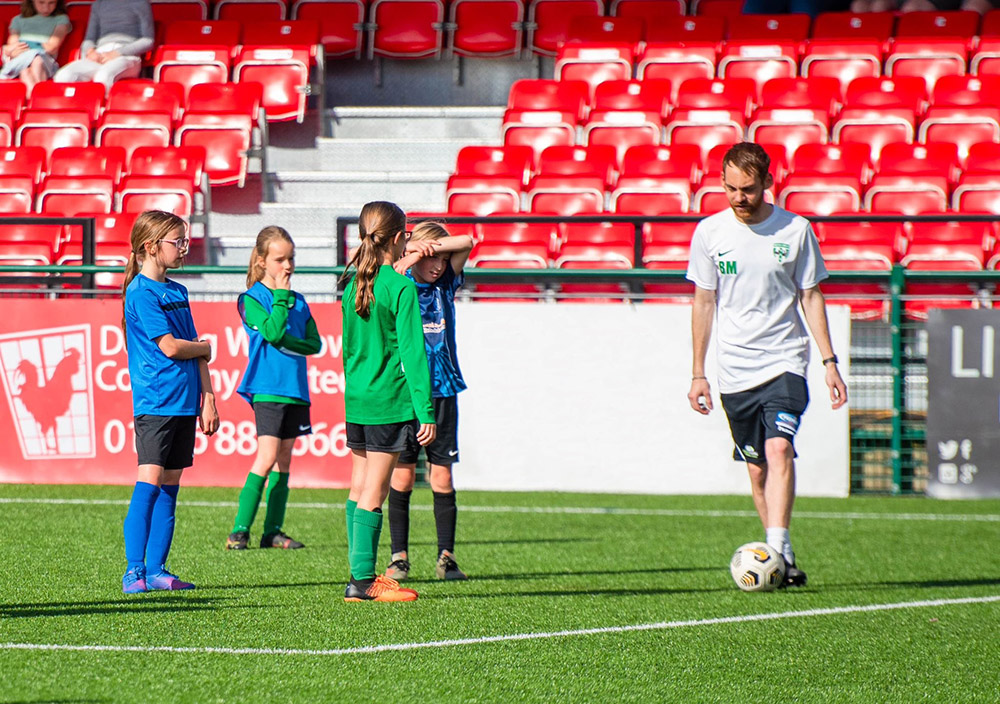
13 tips for men coaching women’s and girls’ football
by Gareth Thomas
Mole Valley Girls FC coach
After switching over from coaching boys’ to girls’ football, I realised I needed to adapt some of the approaches I’d used in the past.
Previously, I’d taken a poorly performing boys’ team, beset by in-fighting and dreadful results, to two consecutive league and cup doubles.
When I began coaching a girls’ U15 team, my naive assumption was that I could simply ‘cut and paste’ the same techniques that had been successful with the boys.
I quickly learned this wasn’t so.
I discovered that some of the drills, motivational techniques, and even language I’d used across the past four seasons were completely counterproductive in a female setting.
Ultimately, I strongly believe women and girls’ football will benefit from having far more female coaches. But until that happens, men will continue to play an important role.
So I thought it would be useful to share some tips for any men making the transition across to women and girls’ football.
The tips that follow are a combination of things I’ve learned, as well as thoughts from other coaches (male and female) at Mole Valley Girls FC. I also canvassed the views of some of the older female youth players at the club.
It’s important to stress that the tips are meant to be thought starters only. They won’t apply in every women and girls football situation, and I’m acutely conscious of the risk of gender stereotyping here. In reality, the dynamic of every group is different, and smart coaches on the ground will know what works best for their players. But hopefully, there are also some useful nuggets for both male and female coaches.
#1 — Girls are just as competitive as boys
One thing I’d often heard was that most girls play football for the social side and are less interested in winning. Whilst the social side is important (see #9), I’ve found that girls are generally just as competitive as boys and are much happier when winning. This is important to understand as you can then explain why you’re running certain drills, or asking for particular improvements, by linking it back to the girls’ desire to win.
#2 — Being inclusive trumps a ‘win at any cost’ approach
A competitive desire to win does not mean a ‘win at any cost’ approach will work. Girls are more likely to spot if weaker players aren’t getting attention or game time — I’ve found that they look out for each other and would prioritise a happy, overall group atmosphere over a win. One young player said:
“I think it’s really important that coaches prioritise giving encouragement and attention to weaker or newer players who lack confidence as this makes the whole group stronger.”
A coach commented, “You get a premium for being very aware of the underlying politics of the group and nipping stuff early, managing differentiation to work to a consistent level of effort rather than player x or y being amazing, ensure values are realised rather than just talked about.”
Of course, an inclusive approach is best practice whatever the gender of the group, but girls do seem more tuned into this issue than boys in my experience.
#3 — Be ready for more questions
When briefing / debriefing boys, getting them to contribute was like drawing blood from a stone. I’ve found girls are much more likely to want to contribute observations and ask questions. They also are more interested in the finer details — for example, the record of the opposition, implications of a result for our league position, etc. In the boys/men’s game, I think players questioning tactics is sometimes (wrongly) seen as a challenge to the authority of a coach. I now consciously leave ample time at the end of the session to listen to the girls and talk everything through.
#4 — Be extremely mindful of language around size
‘Use your size to dominate him’ ‘You’re big, so be first in the defensive wall’; ‘Use your size to protect the ball’. These were all common shouts I’d make to taller/larger players in the boys team. They are also all phrases that are off-limits in the girls’ game, where players are vulnerable to body image issues. The girls — and female coaches — have told me that talking about strength and power is fine, but I should steer clear of anything that relates to size, height, or shape. In other words, focus on the benefit, rather than the physical characteristic that might be enabling it.
#5 — Plan for a more passing-focused game
Any fans of Pep’s tika-taka football will be pleased to hear that female football teams tend to adopt a more passing/possession-based game more quickly than boys. So, it pays to devise lots of drills focused on precision passing and first touch. Men’s and Women’s football are different — neither is better, they’re just different. As one coach explained, ‘[The women and girls’ focus on passing] …can create some of the most sublime passages of play that you will ever witness in grassroots football.”
#6 — Shooting: encourage girls to play to their strengths
When it comes to shooting power, boys have more, as they tend to be stronger physically. Of course, some girls can outpower some boys but for the most part, there is an obvious difference. I’ve often seen girls playing in mixed teams get demoralised if they can’t match the power play of boys’ shots. What I’ve tried to do is coach them to adopt a different style — for example encouraging accurate side-footed passes into the corner of the net, rather than than always trying to power a shot top-bins. As per #5, girls’ teams tend to pass more effectively anyway, so this approach can quickly improve the team’s shot/goal ratio.
#7 — It’s ok to say ‘man on’
It may sound weird shouting ‘man on’, but many girls seem to use the phrase naturally and don’t take offence at the term. In fact, in an (admittedly, unscientific) poll of older (14+) MVGFC players, 90% of girls said they preferred ‘man on’ to alternatives like ‘player on’ or ‘girl on’.
#8 — Respect personal space
Occasionally with the boys, I would run alongside them in sprinting drills if I felt they were coasting. ‘Surely you’re faster than an old man like me?’ etc. It spurred the boys on, but this was 100% a fail when I tried it with the girls. Without doubt, they wanted me out of their personal space — and understandably so!
#9 — The social side is a major factor why girls play — so embrace it!
It took me a while to realise that making time for the girls to have a good chat with their mates at the start of a session was important. I began by trying to force really prompt starts that went straight into drills or games. But I realised that giving them five minutes to chat as they warmed up on their own would improve attention and I’d be rewarded with a far more focused group for the remainder of the session.
#10 — ‘That time of the month’ is absolutely none of your business
As a coach you try to get to know your players and act as a sounding board for other issues players might be dealing with at any point in time which might impact performance. But there’s a line, as one young player explained, “We are going to have bad days usually when it’s that time of the month, and not many will want to talk about it even if it was a female coach so just be patient and don’t make a joke about it cause that will just annoy us.”
#11 — Boys are often over-confident; girls need a confidence boost
Coaching boys, half the job was keeping the egos of the stronger players in check. With the girls, it quickly became obvious to me that most lacked confidence. I’ve found it really helpful to use positive reinforcement, as well as one-to-one chats with the girls to ensure they have a steady flow of positivity. There is no doubt in my mind that they respond better to positive encouragement. When I have to address a negative behaviour, such as a lack of focus or effort, I address the group as a whole, not individuals. Another coach commented, ‘When giving advice to a player, don’t shout it across the pitch on match day so all can hear. Sometimes it is worth even bringing a player off for five minutes to explain one-to-one what you would like them to try. Or do it at half time — just not in front of the whole group as it can be seen as demotivating criticism.’
#12 — The playing kit matters
Linked to the language point (#4) is the provision of kit. If kit is the wrong size or unflattering, you’re going to hear about it quickly. Research shows that to support girls through their adolescent years, more than two-thirds of girls’ clubs offer alternative colours to white shorts, while 45% offer kit tailored for girls and 37% make sanitary products available. I’m pleased to say MVGFC does all of this really well.
#13 — Girls need more encouragement to get aggressive on the pitch
Football is a contact sport, meaning aggressive (fair) play can be a huge advantage. But dropping a shoulder against another player, or putting in a hard slide tackle doesn’t come naturally to all girls. Especially not on a sleepy Sunday morning. So it can be helpful to use aggression ‘ice-breakers’ ahead of matches. As part of pre-match warm-ups, I’ve taken a leaf out of the rugby coaching playbook. I have girls work in pairs and do things like wrestling, shoulder challenges; or playing a game where they face each other in a press-up position and try to knock their opponent’s hands away. This means first contact during a match doesn’t feel awkward or unexpected and a high-pressing strategy is more effective if adopted.
Other Useful Sources:
- Every coach should ALWAYS do the FA safeguarding course, which deals with many more sensitive issues not covered above. Read more here.
- Nearly a third of girls who play football stop playing by the time they reach their late teens — some useful insights on why here.
- Why is it that just 30% of coaches are female? Some interesting perspectives on this subject, and what is being done to address this hereand here.
- England player Fran Kirby recently spoke eloquently about how body image issues had affected her.
![]()
